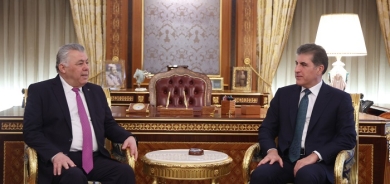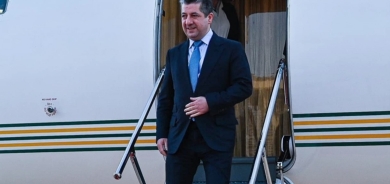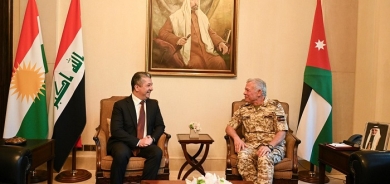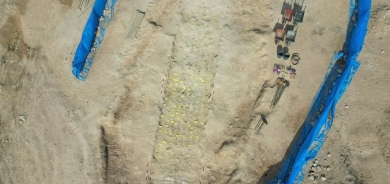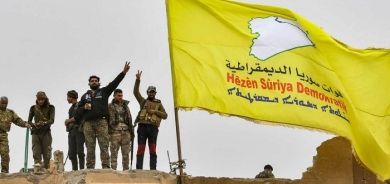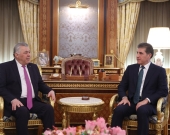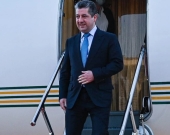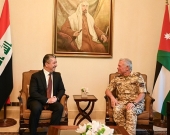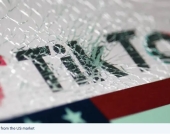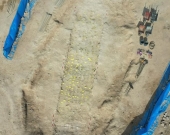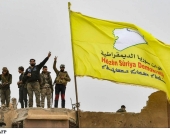Art Brings Color and Therapy to the Lives of Refugee Children in Kurdistan

AKRE, Kurdistan Region – On the walls of a rundown Saddam-era prison fringed by the Kurdish mountains, they painted dreams of peace, their brushstrokes and illustrations expressions of emotions they would otherwise not be able to voice.
As the conflict in Syria continues to ravage, its worst victims are the children and youth who bore witness to unspeakable horrors, and whose short lives were uprooted when they were forced to flee their homes and abandon all that was once familiar.
To help them cope with the present and overcome the trauma they have been through, non-governmental organizations (NGOs) are increasingly turning to creative art projects for the substantial therapeutic benefits they offer. Having recognized the importance of such activities, local NGO Rise Foundation initiated a mural painting project earlier this month for Syrian youth living in the Akre Refugee Camp in the Kurdistan Region of Iraq.
Nils Henrik Johansson, project coordinator with Rise, says the mural idea came to him after seeing a drawing on a wall at Akre during one of his initial visits to the camp. “I want to go home,” it said.
Johansson says the project is being carried out almost entirely by the youth in the camp, under the guidance of a resident artist and local and foreign volunteer art enthusiasts. The youth are involved in every step of the project to foster a sense of responsibility, pride and value in what they create.
“The project has several objectives,” Johansson explains. “It provides a means of expression for the youth of the camp to unleash their creative minds, it encourages positive engagement between the refugee community and local and foreign artists, and it is transforming the aesthetics of the former prison – bringing light and color to an otherwise derelict and menacing structure.”
Sushma Legendre McIntosh, a French art therapist, says activities like the mural project have both short-term and long-term therapeutic benefits for children living in refugee camps.
“In the short-term, drawing and painting makes children feel good and whole, responsible and empowered. It removes them from the refugee camp environment and focuses them on the present moment. The goal is to take them out of their misery and give them a chance to be a child again, to have fun, to make them laugh – and in that moment they’re no longer a refugee in a camp, they’re a child doing art.”
For children forced to start life over at such a young and formative age within a restrictive environment, art projects provide a creative outlet to express themselves and help discover who they really are.
“They are so young to be restarting their lives, and it’s important for them to be aware of who they are without a limiting status. They are not just a refugee, they are a unique individual. And art helps foster their sense of self-identity,” McIntosh explains.
In the long-term, McIntosh notes, all camp residents -- not just children -- will benefit from the visual impact of the murals, which carry happy memories of the residents, and messages of hope.
Inside a tent within Akre, a pile of sketches strewn on the floor depict scenes of blood, killing and war -- not the kind of work you would expect or want to see drawn by a group of children. But given what they have been through, such expression is a natural way of coping and part of the healing process, explains McIntosh.
“I think they need to try and get it out of their system – the war – though it might not work the same for all children,” McIntosh adds.
By late afternoon, walls that once stood bleak and imposing had been transformed into a canvas of vibrant murals dried quickly by the warm April sun.
Yara and Vian, 15-year-old friends who participated in the murals, said the children in the camp were eager for more art projects.
“This is the first time we’ve done a project here with painting, and to be able to paint the walls has been a dream come true for many children here,” Yara says.
For Vian, art holds the memories of home alive, while allowing her to be hopeful about the future, “I used to draw in Syria, and now, while I’m here, I want to paint.”
Lorin, an art teacher from Syria who now lives in Akre and helps oversee the project, says the opportunity to be creative has been good for the children, who are trying to come to terms with their feelings of the war back home.
“The children are so happy that they can express themselves this way. They’ve enjoyed painting, and being able to express themselves, so much that they want to paint the walls of their homes now as well.”
Rudaw

